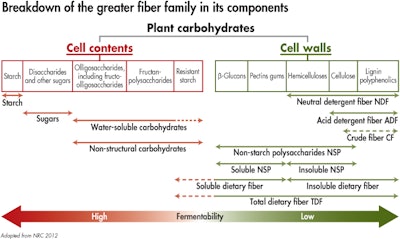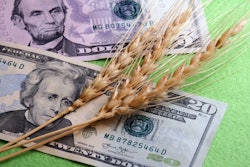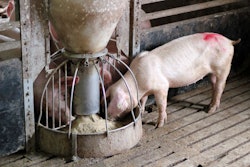
Crude fiber is no longer ideal for feeding modern pigs.
The removal of antibiotics from feeds has upgraded the role of fiber from unwanted to valuable nutrient that improves gut health. But, the traditional determination of crude fiber is no longer suitable (except for feed labels).
Crude fiber refers only to lignin and most celluloses — two components of a much greater fiber family, giving only a rough yet incomplete representation of the overall fiber concentration. Modern nutrition thinking requires a thorough profiling of all fiber components: pectins, hemicelluloses, all celluloses, beta-glucans, lignins and gums. In fact, we need information as to the chemical, physical, and biological role of each fiber component.
As an example, targeted dosages of insoluble fermentable fibers reduce diarrhea in piglets, whereas the same fibers at alternative dosages can be part of the solution to reduce constipation in sows. Clearly, crude fiber analysis cannot account for such disparate roles. Today, there is a movement to define an ideal fiber profile for each class of pigs, in terms of solubility and fermentability.
Quantitative analyses combined with qualitative data
The greater fiber family consists of so many chemically different compounds that no single analytical method can account for total fiber content in feedstuffs.
The least efficient is “crude fiber” which gives a vague idea of fiber quantity but not its quality. More recent methods, namely the acid detergent fiber (ADF) and neutral detergent fiber (NDF), provide a slightly improved picture. The first (ADF) accounts for all celluloses and lignin, whereas the second (NDF) includes all hemicelluloses, celluloses, and lignin. ADF and NDF leave out beta-glucans and pectins, which have significant nutritional value (see Graph 1).
 Fiber is a terminology that encompasses many diverse compounds with disparate chemical, physical and biological properties.
Fiber is a terminology that encompasses many diverse compounds with disparate chemical, physical and biological properties.More importantly, neither ADF nor NDF provides any information on biological functions within the gut. For example, not all celluloses escape fermentation, nor are all hemicelluloses soluble, etc. Under the ideal fiber profile initiative, quantitative chemical analyses will be combined with qualitative biological data to enhance formulation precision and accuracy.
Insoluble fiber is beneficial at the upper gut segment
The functional properties of fibers are best described in terms of solubility and fermentability. Solubility refers to the ability to be dissolved in water — think of table sugar getting dissolved in a glass of water. The degree to which a fiber is soluble affects viscosity in the small intestine, which in turn reduces transit time, and hampers access to enzymes ending in lower digestibility for all nutrients. Thus, excess solubility is an undesirable trait. However, we cannot exclude all soluble fibers because most soluble fibers are fermentable, and we definitely need them.
On the other hand, insoluble fibers at the right concentration promote gut motility. Motility is a a complex phenomenon resulting from the combination of inert and fermentable fibers; the latter through microbiota nourishment result in the production of gut neuro-mediators. Insoluble fibers absorb water instead of being dissolved into it — think paper napkins that are practically pure cellulose. Trapping water addresses normal hydration of the digesta mass in transit, so has a key physiological role, whereas such water is partially released at the large intestine level where it may re-enter the systemic circulatory system.
Fermentable fiber is beneficial at the lower gut segment
Some functional fibers are fermented at the upper gut, but the majority is fermented by beneficial bacteria at the large intestine. Fiber fermentability in the large intestine is related mostly to prebiotic effects promoting gut health. Of course, the degree to which fermentable fibers can be utilized by gut microbiota depends primarily on their chemical composition.
Solubility also affects fermentability as the more soluble a fiber component is, the more rapidly it can be fermented. Some examples: pectins and beta-glucans are highly fermentable, whereas hemicelluloses and celluloses are fermentable to a lesser degree, with lignin being non-fermentable. Also, it has been shown that fiber particle size affects fermentability; a finer particle size results in higher fermentability. It merits pointing out that insoluble fiber is not necessarily non-fermentable. A prime example can be found in the case of specific blends of wood lignocellulose which include bark that contains slowly fermentable prebiotic fibers.
Practical example No. 1
In pigs, the best example of beneficial use of fiber is that of relieving constipation in gestating sows. These animals receive a controlled amount of feed that may cover their nutrient requirements, but it is not enough to provide for healthy bowel movements. Traditionally, adding wheat bran, beet pulp, or soy hulls has been deemed adequate, although results varied considerably. For example, wheat bran is high in hemicelluloses, beet pulp is rich in pectins, whereas soy hulls contain a bit of everything.
Regardless of the variable fiber profile, such ingredients face other unavoidable issues: high prices, mycotoxins, seasonal availability, etc. They are also bulky, which makes storage/handling of complete feeds a real challenge. Concentrated fibers offer a modern approach that resolve the above issues, without being more expensive. Going back to the bark-rich prebiotic fibers, we can even combine the benefits of gut peristalsis with prebiotic effects – something that may even lower feed cost.
Practical example No. 2
Piglet diarrhea is the exact opposite of sow constipation, yet it is possible to address both with insoluble fibers; the key is in the dosage. Piglets require just enough insoluble fibers to avoid three important diarrhea predisposing factors.
- Piglet diets are naturally rich in soluble fibers (hemicelluloses, pectins) that increase viscosity, which favors pathogens and reduces feed digestibility. Insoluble fibers reduce viscosity.
- Piglets often drink too much water post-weaning to compensate for reduced feed intake. Piglet diets are also rich in lactose/sugar and minerals that can cause osmotic diarrhea, and other ingredients that may cause gut inflammation. Insoluble fibers help in water balance at the upper gut section, whereas fermentable fibers support the microflora to counter gut inflammation.
- Piglets right after weaning have steep ups and downs in feed intake leading to nutrient indigestion and malabsorption that damage the gut and provide food to pathogens. Insoluble fibers control feed intake avoiding gut overload.
Practical example No. 3
It is no secret anymore that a healthy gut microbiota is the key to overall gut health, especially in the absence of antimicrobial agents.
There is considerable confusion regarding fermentable fibers. For example, not all soluble fibers are desirable and not all insoluble fibers are non-fermentable, as previously thought. A great number of prebiotic fibers (fermentable) is available in the form commercial additives. Most of them are indigestible oligo- or polysaccharides and of course, not all work with similar efficacy.
The fermentability of celluloses has been overlooked. Up to 20% of some celluloses can be fermented, offering thus a prebiotic effect without the undesirable effects of solubility (viscosity). Fermentable fibers are required by gut microbiota as a source of energy. In their symbiotic relationship, microbiota offer back energy to the host in the form of their waste products, namely volatile fatty acids. Having the right microbiota and promoting their growth offers many more benefits in terms of gut health, immunity and even diarrhea/constipation control.
Balance in feed formulation
It is clear by now that crude fiber and simple chemical analyses of fibers are no longer enough for modern pig nutrition applications, and we need to include in feed formulation specifications for insoluble and fermentable fiber fractions.
Although we have sufficient data for most common ingredients regarding their insoluble/fermentable fiber components, we still lack a comprehensive database that would include all ingredients used today. To this end, there are research efforts going on that will bear fruit in the near future.
We also lack a quantitative assessment of the ideal fiber profile. Namely, we need to know how much insoluble and fermentable fiber we need in each feed we formulate. As it is to be expected, such balance will be different for each class of animals. And, of course, we assume the values are linearly additive, something that should be verified. Nevertheless, we have some empirical evidence that can be used as a starting point.
More biological functions
Fibers do not exist in isolation. The majority of fiber sources are ingredients containing other substances with beneficial or negative effects on animal nutrition and health. The most striking example is the potential of concentrated mycotoxins in wheat bran or the unavoidable presence of silica in rice hulls (which has a very strong gut abrasive action leading to profuse diarrheas).
On the other hand, beneficial compounds include antioxidants and even vitamins. This brings us back to the bark-rich prebiotic fibers discussed previously that contain a number of other natural compounds with considerable antioxidant properties, something that is being valued quite highly today. So, not all fibers are just fibers.

















